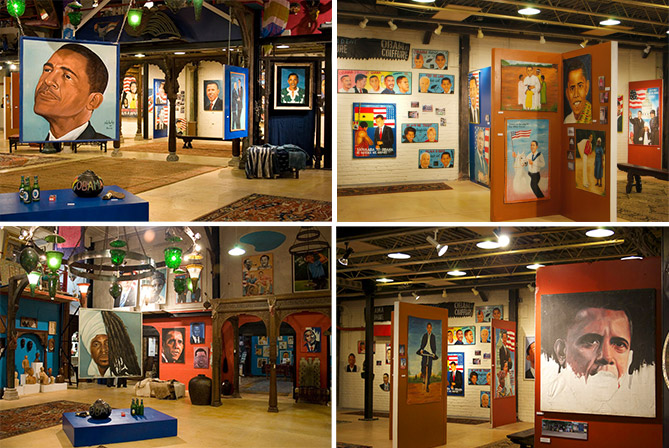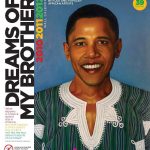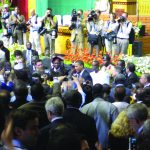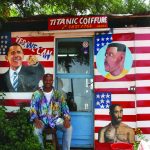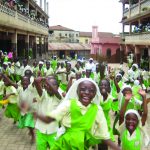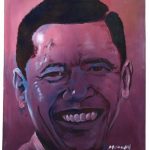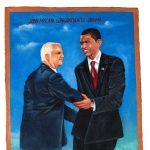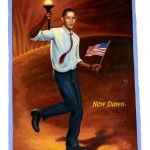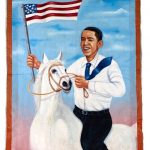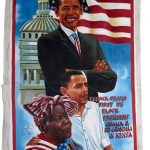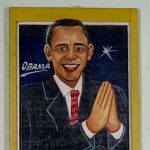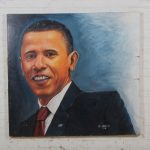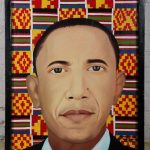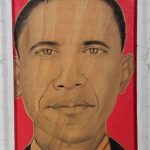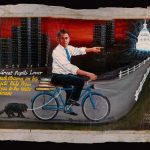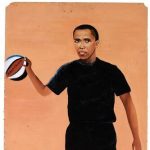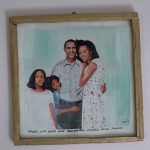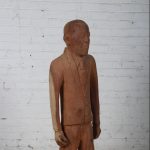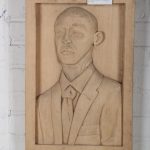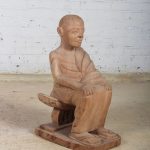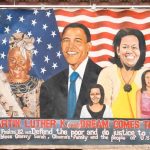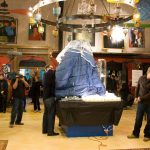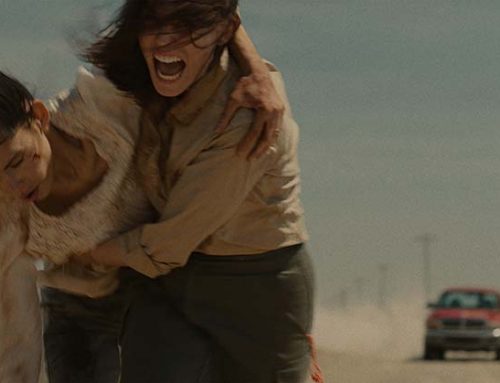DREAMS OF MY BROTHER:
VISIONS OF OBAMA BY FOLK AND POPULAR AFRICAN ARTISTS
August 6 to September 6, 2016
A Retrospective Exhibition of Works Collected in Africa in 2008-2009
Calendar/Exhibition Essay by George Jevremovic, November 4, 2009
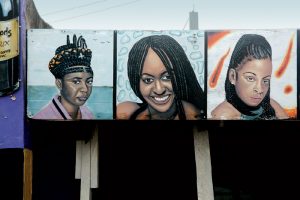 WELCOME PROOF THAT THERE IS NO such thing as “the art world,” only worlds of art, are the legions of folk and popular artists in Africa, from Ghana to Kenya, Togo to Mali, whose painted works on board, canvas, metal or wall surface —seen daily by an audience of millions — provide visual branding and identity to thousands of small businesses and enterprises: beauty salons, tailors, cinemas, grocery stores; on and on. From free-standing ma and pa’s to itinerant vendors, late-night cafes to trucks for hire, herbalists to hairstylists, their commissioned works serve the common, practical purpose of advertising anywhere: to stand out and be noticed.
WELCOME PROOF THAT THERE IS NO such thing as “the art world,” only worlds of art, are the legions of folk and popular artists in Africa, from Ghana to Kenya, Togo to Mali, whose painted works on board, canvas, metal or wall surface —seen daily by an audience of millions — provide visual branding and identity to thousands of small businesses and enterprises: beauty salons, tailors, cinemas, grocery stores; on and on. From free-standing ma and pa’s to itinerant vendors, late-night cafes to trucks for hire, herbalists to hairstylists, their commissioned works serve the common, practical purpose of advertising anywhere: to stand out and be noticed.
For a first-time visitor, it can be exhilarating and shocking: global and local brands, African and non-African celebrities and international icons; all appropriated and rendered in a mosaic of popular and homegrown styles, languages and regional dialects; all competing for the attention of the passerby. Many are signed and dated or feature a studio’s logo, and every day more of them display cell phone numbers and e-mail addresses drawn with the fluid skill of a calligrapher.
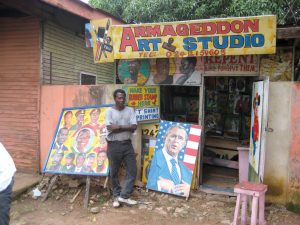 Traveling to West Africa in the 90’s in search of traditional textiles, artifacts, carvings, I felt that nothing made a greater impression — from city to countryside — than the signs, banners, portraits and messages along the way. Veering from service-oriented to visionary, product-focused to didactic, informative to apocryphal, they were testament to the fact that human creativity is as abundant as it is uneven. They recalled a time when, out of necessity, all signs were “read by hand.”
Traveling to West Africa in the 90’s in search of traditional textiles, artifacts, carvings, I felt that nothing made a greater impression — from city to countryside — than the signs, banners, portraits and messages along the way. Veering from service-oriented to visionary, product-focused to didactic, informative to apocryphal, they were testament to the fact that human creativity is as abundant as it is uneven. They recalled a time when, out of necessity, all signs were “read by hand.”
While commissioned works by definition fit the specific needs of clients, many — particularly those made to showcase the roadside venues of the artists themselves, or which lean casually upright in a corner of a studio — reveal a strong spirit of “art for art’s sake.” Such works are filled with personal agendas, irony, politics, word-play, invention, and an impulse to think outside the margins and stay a step ahead of the pack.
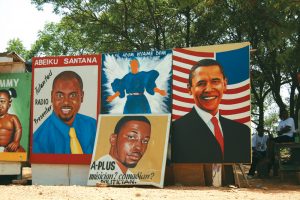 When art forges deep connections in the cauldrons of commerce and culture, in places like Nima and Teshie (two thriving communities of Accra), categories blur into new focus, releasing talent and vision, turning western concepts of art as luxury upside clown, or — more aptly — inside out. Reputations are earned as they are made, testing apprentices and attracting commissions. Just as new styles flourish in the open air (so much painting is done outdoors in plain sight!) they also fade rapidly away, taking on the patina of age, exposed to the corrosive elements of wind and weather, not to mention changes in fashion and popular taste.
When art forges deep connections in the cauldrons of commerce and culture, in places like Nima and Teshie (two thriving communities of Accra), categories blur into new focus, releasing talent and vision, turning western concepts of art as luxury upside clown, or — more aptly — inside out. Reputations are earned as they are made, testing apprentices and attracting commissions. Just as new styles flourish in the open air (so much painting is done outdoors in plain sight!) they also fade rapidly away, taking on the patina of age, exposed to the corrosive elements of wind and weather, not to mention changes in fashion and popular taste.
What remains constant, what keeps filling the oncoming, clattering void of market days and processions, is the energy of communities of artists to adapt and change, to serve the pulse and needs of a real audience, with work meant for —mostly — outdoor display. Interestingly, in many places — especially in West Africa — demand has increased rather than diminished over time, reflecting the growth of small businesses and enterprises that find the hand-painted sign an affordable, aesthetically preferable alternative to the machine-printed one.
Exhibitions in recent decades at international museums and galleries, along with the publication of books, articles and catalogues, have raised public awareness of what can objectively be described as one of the most vibrant, popular —not to mention entrepreneurial — grassroots art movements in the world. We hope this calendar and related exhibition will add to a growing appreciation and understanding of folk and popular African art, with a twist that is timely and could not have been predicted: the election of Barack Obama as the 44th President of the United States of America.
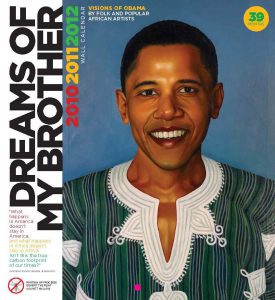 Our idea was to locate, collect and exhibit a group of artworks created during and leading up to his first year in office, sensing that something so seismic, so public, and yet so personal for so many, would find fertile ground among African artists. We were not disappointed. The decision to feature a selection of Obama-inspired African art in an “eco-conscious, recession-sensitive, printed-in-USA 39-month calendar” was metaphorical and practical: if these are historic and challenging times for the “most powerful nation in the world,” and for the world in general, then they are acutely so for Africa in particular. What happens in America doesn’t stay in America, and what happens in Africa doesn’t stay in Africa. Isn’t this the true carbon footprint of our times? A calendar seemed the most efficient way to launch what for many may arrive as unexpectedly as a message washed ashore in a bottle.
Our idea was to locate, collect and exhibit a group of artworks created during and leading up to his first year in office, sensing that something so seismic, so public, and yet so personal for so many, would find fertile ground among African artists. We were not disappointed. The decision to feature a selection of Obama-inspired African art in an “eco-conscious, recession-sensitive, printed-in-USA 39-month calendar” was metaphorical and practical: if these are historic and challenging times for the “most powerful nation in the world,” and for the world in general, then they are acutely so for Africa in particular. What happens in America doesn’t stay in America, and what happens in Africa doesn’t stay in Africa. Isn’t this the true carbon footprint of our times? A calendar seemed the most efficient way to launch what for many may arrive as unexpectedly as a message washed ashore in a bottle.
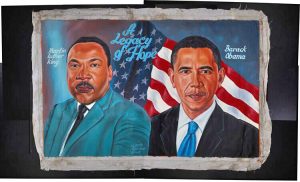 Seen here is the public Obama, who carries on the “legacy of hope,” who on his first visit to sub-Saharan Africa as President, said: “Fifty-two years ago, the eyes of the world were on Ghana. And a young preacher named Martin Luther King travelled here, to Accra, to watch the Union Jack come down and the Ghanaian flag go up. Dr. King was asked how he felt watching the birth of a nation. And he said: ‘It renews my conviction in the ultimate triumph of justice’ ” (Accra, Ghana, 11 July 2009). And there’s the Obama that speaks truth to power, who, as a Senator from Illinois told an audience in Nairobi: “In the end, if the people cannot trust their government to do the job for which it exists — to protect them and to promote their common welfare — all else is lost.” (28 August 2006).
Seen here is the public Obama, who carries on the “legacy of hope,” who on his first visit to sub-Saharan Africa as President, said: “Fifty-two years ago, the eyes of the world were on Ghana. And a young preacher named Martin Luther King travelled here, to Accra, to watch the Union Jack come down and the Ghanaian flag go up. Dr. King was asked how he felt watching the birth of a nation. And he said: ‘It renews my conviction in the ultimate triumph of justice’ ” (Accra, Ghana, 11 July 2009). And there’s the Obama that speaks truth to power, who, as a Senator from Illinois told an audience in Nairobi: “In the end, if the people cannot trust their government to do the job for which it exists — to protect them and to promote their common welfare — all else is lost.” (28 August 2006).
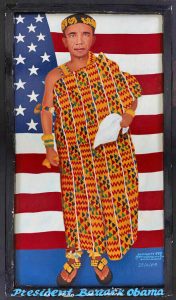 Artistic license doesn’t end in a merely public Obama, an event personified, but includes the personal and the kitsch, dreams and visions, sincerity and self-promotion, success and failure, the good, the bad, the beautiful, the borrowed. and — occasionally — the audaciously original. Sounds like art imitating life — and politics! When Kwame Akoto, an artist of considerable talent and vision, depicts Obama in a Kente cloth and sandals, holding a horse-tail whisk while standing in front of the American flag, the result is a collision of cross-cultural patterns and inherited meanings. But instead of crashing and burning under such a heavy load, Akoto’s symbol-wrapped, envelope-pushing image of Obama appears undaunted; in fact, he seems to hover above the fray of identity politics altogether. Classical and yet fittingly post-modern, this is a figure cut from the cloth of the Greek and Roman philosophers: rational to an extreme; calm in the face of complexity; comfortable in his own skin.
Artistic license doesn’t end in a merely public Obama, an event personified, but includes the personal and the kitsch, dreams and visions, sincerity and self-promotion, success and failure, the good, the bad, the beautiful, the borrowed. and — occasionally — the audaciously original. Sounds like art imitating life — and politics! When Kwame Akoto, an artist of considerable talent and vision, depicts Obama in a Kente cloth and sandals, holding a horse-tail whisk while standing in front of the American flag, the result is a collision of cross-cultural patterns and inherited meanings. But instead of crashing and burning under such a heavy load, Akoto’s symbol-wrapped, envelope-pushing image of Obama appears undaunted; in fact, he seems to hover above the fray of identity politics altogether. Classical and yet fittingly post-modern, this is a figure cut from the cloth of the Greek and Roman philosophers: rational to an extreme; calm in the face of complexity; comfortable in his own skin.
If Obama’s journey in the African imagination, like his presidency, is a work in progress, it comes as no surprise that his victory, in hearts and minds across Africa, arrived well before November 2008, gaining momentum with every CNN broadcast and daily headline, a sort of parallel offshore election won in a landslide before a single real vote was cast in the USA. It’s a given that the Obama brand would start an avalanche of faux products and political endorsements, bogus associations of every stripe and flavor. But he is not the first American president subjected to artistic scrutiny or commercial appropriation on foreign shores–in the 1960’s, JFK’s likeness was a favorite among pictorial carpet weavers its Iran!–and he likely won’t be the last. There are flocks of Clintons (especially in Ghana) and even the occasional Bush. On a sliding scale, Bob Marley, Jesus Christ, Michael Jackson, Kofi Anan, Che Guevara and Nelson Mandela may still cover more surface, though it’s easy to see the cellular structure of the whole canvas changing, adding Obamas by the day.
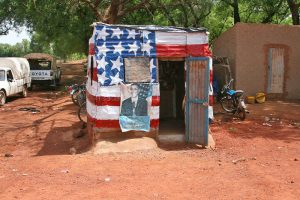 What is jarring, however, what arrives so randomly and inexplicably, like an iceberg in the desert, is the corrugated tin roadside shack — sitting just down the road from Timbuktu, in Mali — painted with the stars and stripes of the American flag and anchoring a faded and tattered Obama poster. This isn’t Kansas: taken out of context, it could be a piece of installation art; seen here, it makes a far more powerful statement. If it’s true, as Obama said in Accra, that “Africa doesn’t need strongmen, it needs strong institutions,” it follows that it needs a model to inform and guide it. Right now, for many ordinary Africans, that model comes distilled in the form of the United States with Barack Obama as its President. As an elected American official, Obama’s message to Africa has been consistent, supportive, carefully diplomatic, so as not to raise hopes that change in Africa will come from anywhere but Africa itself: “We must start from the simple premise that Africa’s future is up to Africans.” Fair enough. When he tells an African audience that the future, the world’s future, depends upon “transformational change,” he does so in the context of one whose own life story raises the bar of what is imaginable, not just possible.
What is jarring, however, what arrives so randomly and inexplicably, like an iceberg in the desert, is the corrugated tin roadside shack — sitting just down the road from Timbuktu, in Mali — painted with the stars and stripes of the American flag and anchoring a faded and tattered Obama poster. This isn’t Kansas: taken out of context, it could be a piece of installation art; seen here, it makes a far more powerful statement. If it’s true, as Obama said in Accra, that “Africa doesn’t need strongmen, it needs strong institutions,” it follows that it needs a model to inform and guide it. Right now, for many ordinary Africans, that model comes distilled in the form of the United States with Barack Obama as its President. As an elected American official, Obama’s message to Africa has been consistent, supportive, carefully diplomatic, so as not to raise hopes that change in Africa will come from anywhere but Africa itself: “We must start from the simple premise that Africa’s future is up to Africans.” Fair enough. When he tells an African audience that the future, the world’s future, depends upon “transformational change,” he does so in the context of one whose own life story raises the bar of what is imaginable, not just possible.
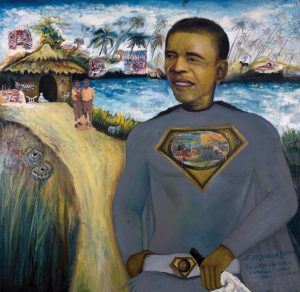 One wonders, in light of the just announced decision to award Obama the 2009 Nobel Peace Prize, whether Ibrahim Iddrisu’s textured, nuanced vision of Obama-as-Peacemaker was an act of inspired prophecy, an expression of fraternal hope for a better future, good timing, or all of the above? (Some might be tempted to ask the same question to the Nobel judges). As if he saw the question coming, Iddrisu wrote this message on the back of his painting: “Africans believe Obama is a Superman, a Messenger who will help to develop the educational level of Africa to a higher standard.” Did anyone ever ask so little — and yet, so much — of a Superhero before? Was there ever a more trenchant description of a good role model than this? In Philadelphia, more than a few people have commented how this iconic image reminded them of Edward Hicks’ (1780-1849) Peaceable kingdom paintings and asked whether Iddrisu was familiar with the work (answer: no). The comparison is made all the more interesting by the fact that Hicks began his career as a tavern sign painter working on commissions, years before he began to tap into the “inner light” of his adopted Quaker faith and to paint his inspired utopias.
One wonders, in light of the just announced decision to award Obama the 2009 Nobel Peace Prize, whether Ibrahim Iddrisu’s textured, nuanced vision of Obama-as-Peacemaker was an act of inspired prophecy, an expression of fraternal hope for a better future, good timing, or all of the above? (Some might be tempted to ask the same question to the Nobel judges). As if he saw the question coming, Iddrisu wrote this message on the back of his painting: “Africans believe Obama is a Superman, a Messenger who will help to develop the educational level of Africa to a higher standard.” Did anyone ever ask so little — and yet, so much — of a Superhero before? Was there ever a more trenchant description of a good role model than this? In Philadelphia, more than a few people have commented how this iconic image reminded them of Edward Hicks’ (1780-1849) Peaceable kingdom paintings and asked whether Iddrisu was familiar with the work (answer: no). The comparison is made all the more interesting by the fact that Hicks began his career as a tavern sign painter working on commissions, years before he began to tap into the “inner light” of his adopted Quaker faith and to paint his inspired utopias.
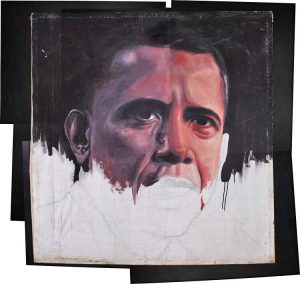 Another work that elicits comparisons and questions is the unfinished portrait of Obama by the artist Sheff. Its resemblance to Gilbert Stuart’s (1755-1828) unfinished portrait of George Washington (National Portrait Gallery, Washington, DC, Boston Museum of Fine Arts) is hard to ignore. It’s worth telling how we came to acquire it: a few hours after attending Obama’s speech in Accra, when the world’s press was focused on the historic symbolism of the First Family’s journey up to Cape Coast (the centuries-long “gate of no return” for countless Africans sold into slavery), we happened on a roadside studio where a young artist in his 20’s was displaying three Obamas: one of a jubilant husband and wife in a victory embrace; the second, a flattering portrait even a mother could love, set against a background of skillfully modulated, official-looking, strobe-lit grays, a flag pin balanced carefully on a lapel. It was the third, the unfinished one, however, that drew our attention the most; its raw poignancy seemed to simultaneously capture the poetry of the moment and to hit the nail on the head. Unlike Gilbert Stuart, who kept his unfinished portrait of Washington as a model for future Washingtons (including the one on the dollar bill), Sheff offered to complete his Obama. He seemed amused more than surprised when we told him that we’d be happy — as long as he agreed — to purchase all the paintings as we found them. “No problem,” he replied. When we asked about the resemblance of certain of his paintings to images in the news, Shelf enthusiastically opened a drawer stuffed with clippings from magazines and newspapers, explaining to us that while photographs had always provided him valuable source material, his desk had never been fuller than it was that afternoon in July.
Another work that elicits comparisons and questions is the unfinished portrait of Obama by the artist Sheff. Its resemblance to Gilbert Stuart’s (1755-1828) unfinished portrait of George Washington (National Portrait Gallery, Washington, DC, Boston Museum of Fine Arts) is hard to ignore. It’s worth telling how we came to acquire it: a few hours after attending Obama’s speech in Accra, when the world’s press was focused on the historic symbolism of the First Family’s journey up to Cape Coast (the centuries-long “gate of no return” for countless Africans sold into slavery), we happened on a roadside studio where a young artist in his 20’s was displaying three Obamas: one of a jubilant husband and wife in a victory embrace; the second, a flattering portrait even a mother could love, set against a background of skillfully modulated, official-looking, strobe-lit grays, a flag pin balanced carefully on a lapel. It was the third, the unfinished one, however, that drew our attention the most; its raw poignancy seemed to simultaneously capture the poetry of the moment and to hit the nail on the head. Unlike Gilbert Stuart, who kept his unfinished portrait of Washington as a model for future Washingtons (including the one on the dollar bill), Sheff offered to complete his Obama. He seemed amused more than surprised when we told him that we’d be happy — as long as he agreed — to purchase all the paintings as we found them. “No problem,” he replied. When we asked about the resemblance of certain of his paintings to images in the news, Shelf enthusiastically opened a drawer stuffed with clippings from magazines and newspapers, explaining to us that while photographs had always provided him valuable source material, his desk had never been fuller than it was that afternoon in July.
However much Barack Obama is the subject and focus, the muse and occasional lightning rod, of a growing body of African folk and popular art, and however much these works may be seen to celebrate the unprecedented fact that an American with an African father was elected to the White House, today it is the ideas embodied in them that are the real work in progress, inspiring the artists and commanding the attention of an audience of millions.
© 2009 Material Culture, Philadelphia, All Rights Reserved

